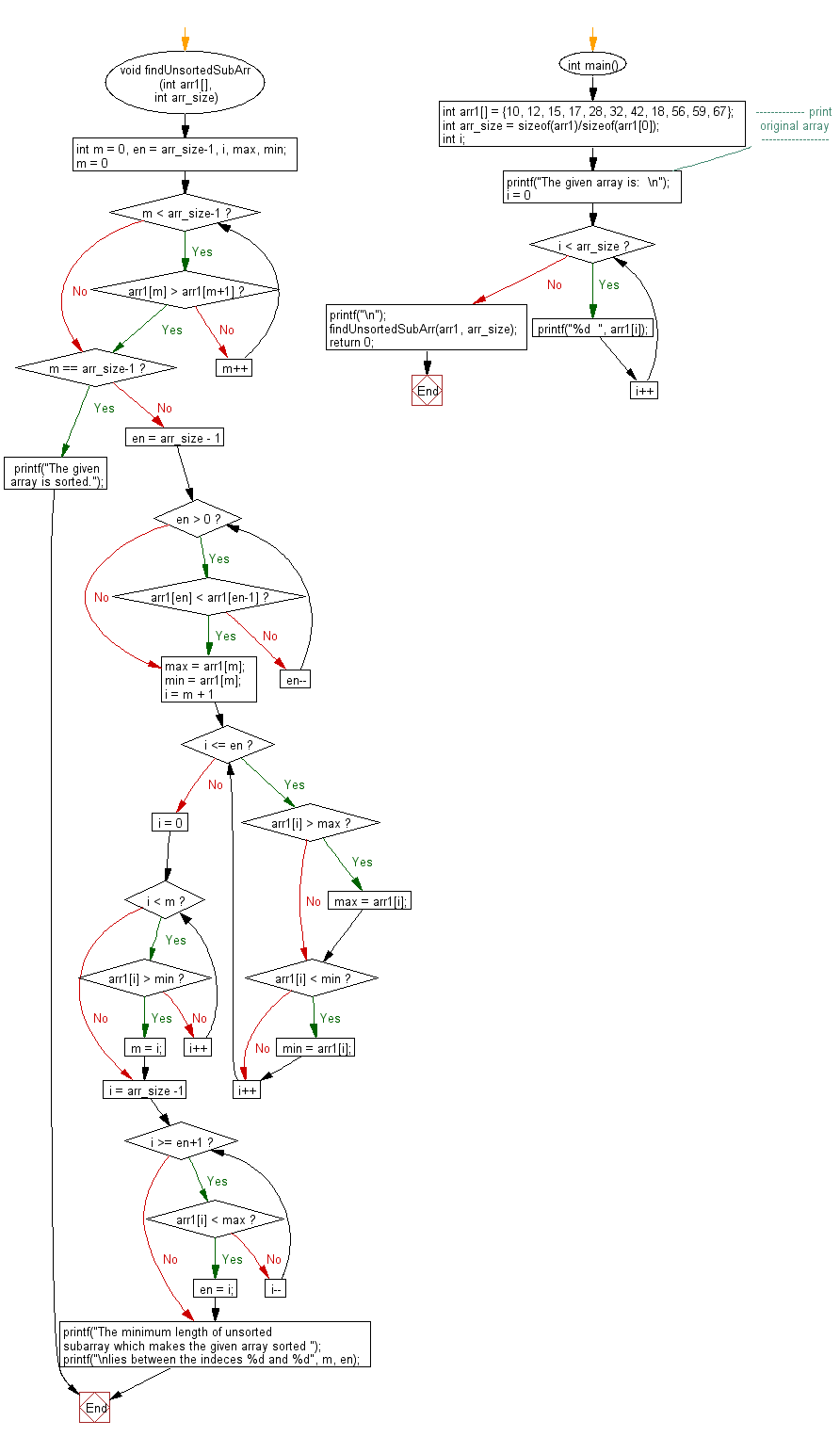C Exercises: Find the minimum length of subarray such that, sorting this subarray makes the whole array sorted
91. Minimum Length Subarray to Sort Array
An unsorted array of a specific size is given. Write a program in C to find the minimum length of a subarray such that sorting this subarray makes the whole array sorted.
Expected Output:
The given array is:
10 12 15 17 28 32 42 18 56 59 67
The minimum length of unsorted subarray which makes the given array sorted
lies between the indeces 4 and 7
The task is to write a C program that finds the minimum length of a subarray in an unsorted array such that sorting this subarray will make the entire array sorted. The program should determine the starting and ending indices of the smallest subarray that, when sorted, will result in the whole array being sorted. The output should display these indices.
Sample Solution:
C Code:
#include<stdio.h>
// Function to find the minimum length of an unsorted subarray
void findUnsortedSubArr (int arr1[], int arr_size)
{
int m = 0, en = arr_size-1, i, max, min;
// Finding the leftmost index where the unsorted part begins
for (m = 0; m < arr_size-1; m++)
{
if (arr1[m] > arr1[m+1])
break;
}
// If the array is already sorted, print it and return
if (m == arr_size-1)
{
printf("The given array is sorted.");
return;
}
// Finding the rightmost index where the unsorted part ends
for(en = arr_size - 1; en > 0; en--)
{
if(arr1[en] < arr1[en-1])
break;
}
// Finding the maximum and minimum elements within the unsorted subarray
max = arr1[m];
min = arr1[m];
for(i = m + 1; i <= en; i++)
{
if(arr1[i] > max)
max = arr1[i];
if(arr1[i] < min)
min = arr1[i];
}
// Adjusting the left index of the unsorted subarray
for(i = 0; i < m; i++)
{
if(arr1[i] > min)
{
m = i;
break;
}
}
// Adjusting the right index of the unsorted subarray
for(i = arr_size - 1; i >= en+1; i--)
{
if(arr1[i] < max)
{
en = i;
break;
}
}
// Printing the indices of the unsorted subarray
printf("The minimum length of unsorted subarray which makes the given array sorted ");
printf("\nlies between the indices %d and %d", m, en);
return;
}
// Main function
int main()
{
int arr1[] = {10, 12, 15, 17, 28, 32, 42, 18, 56, 59, 67};
int arr_size = sizeof(arr1)/sizeof(arr1[0]);
int i;
// Printing the original array
printf("The given array is: \n");
for(i = 0; i < arr_size; i++)
{
printf("%d ", arr1[i]);
}
printf("\n");
// Calling the function to find the unsorted subarray
findUnsortedSubArr(arr1, arr_size);
return 0;
}
Output:
The given array is: 10 12 15 17 28 32 42 18 56 59 67 The minimum length of unsorted subarray which makes the given array sorted lies between the indeces 4 and 7
Visual Presentation:
Flowchart:/p>
For more Practice: Solve these Related Problems:
- Write a C program to determine the minimum subarray that, when sorted, makes the entire array sorted using two-pointer technique.
- Write a C program to find the smallest unsorted subarray using prefix and suffix comparisons.
- Write a C program to compute the boundaries of the subarray that needs sorting and then output its length.
- Write a C program to determine the minimum subarray to sort using a recursive approach to check sortedness.
Go to:
PREV : Rearrange Array so that arr[i] = arr[arr[i]].
NEXT : Check Consecutive Elements in Array.
C Programming Code Editor:
Have another way to solve this solution? Contribute your code (and comments) through Disqus.
What is the difficulty level of this exercise?
Test your Programming skills with w3resource's quiz.

